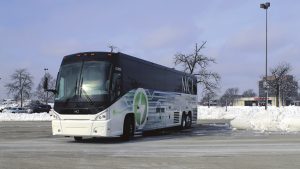 The people from MCI very graciously invited us to take a close look at the first prototype electric J4500e CHARGE coach on the road. Since we knew that our National Bus Trader readers would be interested, we quickly accepted. Hence, we were able to poke our heads into each compartment, take photos and check out all the new and improved systems and components. Following that, we then were invited to jump into the driver’s seat and see how this new electric coach operated. We were also able to obtain information on the coach that we could share with our readers.
The people from MCI very graciously invited us to take a close look at the first prototype electric J4500e CHARGE coach on the road. Since we knew that our National Bus Trader readers would be interested, we quickly accepted. Hence, we were able to poke our heads into each compartment, take photos and check out all the new and improved systems and components. Following that, we then were invited to jump into the driver’s seat and see how this new electric coach operated. We were also able to obtain information on the coach that we could share with our readers.
A condensed report would include the fact that several components and systems were converted from an existing 2017 clean-diesel J4500 to electric operation replacing mechanical or belt-driven items. In spite of these changes and improvements, drivers should have no difficulty in transitioning from diesel to battery-electric power. Your technicians will smile because the J4500e is simpler in operation, is easier to maintain and clean. Although MCI plans to accommodate systems that allow you to charge it along the way, the approximate 200-mile range essentially limits the coach to commuter and shuttle work until higher capacity batteries come along. Due in large part to the expensive batteries, the J4500e will cost about twice as much as the equivalent diesel coach. You will have less underfloor storage space than on the equivalent diesel coach because of the batteries.
Background
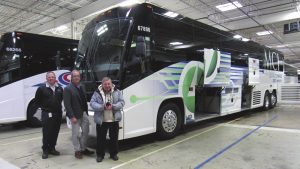 While an electric J4500 was inevitable, the joining of MCI and New Flyer about four years ago moved the project along and also guarantees that the J4500e combines the best of two worlds. On the one hand, it is the result of eight decades of coach building expertise at MCI that has created the most reliable and durable of coaches. On the other hand, the J4500e takes advantage of decades of electric bus experience at New Flyer.
While an electric J4500 was inevitable, the joining of MCI and New Flyer about four years ago moved the project along and also guarantees that the J4500e combines the best of two worlds. On the one hand, it is the result of eight decades of coach building expertise at MCI that has created the most reliable and durable of coaches. On the other hand, the J4500e takes advantage of decades of electric bus experience at New Flyer.
The MCI heritage includes engineering and building coaches that operate reliably in the varied weather, temperatures and roads of Canada. Add to this MCI’s decades of building coaches that meet the exacting needs of Greyhound operations nationwide. The result is a coach that is easily at the top in regard to reliability, durability and operations.
There is 20 years of heritage and development behind the J4500 model. It started in 1998 when MCI introduced their “E” or Renaissance model to offer new styling geared more towards tours and upscale charters. The J4500 was originally introduced in 2001 to offer a “bread and butter” companion to the “E” model. The J4500 soon turned into a Cinderella story. Continued improvements to the J4500 made it more attractive to operators and suitable for scheduled service, charters and tours. By 2004, the J4500 became the most popular coach on the market, a position it has held ever since. These improvements are ongoing. Last year saw a modification in the engine compartment and interior that offered a rear window and more legroom for an increase to 60 passengers. The most recent improvement involved going with an electric fan cooling system with a swing out radiator for the engine compartment that is easier to maintain.
New Flyer’s heritage with electric buses dates back 50 years. Looking for a way to move forward with trolley buses, Toronto asked New Flyer to rebuild one in 1967. It was so well received that an order for 151 similar buses followed. As time went on, New Flyer became a major supplier for electric buses that operated in different cities.
Moving beyond trolley buses, New Flyer developed a hydrogen fuel cell, electric drive and then their battery-electric drive. Today New Flyer’s low-floor Xcelsior transit bus line is available with diesel, CNG, hydrogen fuel cell and battery electric power with the all-electric version falling under the Xcelsior CHARGE™ brand that will be common with MCI. In addition to the shorter transit bus lengths, New Flyer is also producing 60-foot articulated battery-electric buses with bus rapid transit (BRT) features.
Hence, the J4500e CHARGE is in a position to take advantage of both the MCI coach building and the New Flyer electric bus expertise and experience.
Changes in Systems and Components
The single biggest difference between the diesel coach and the electric coach is moving to electric systems and components in a few areas. I stress the fact that none of these significantly changes how you drive the coach and, in many if not most cases, the driver moving from a diesel coach to an electric coach may not even notice these changes.
Obviously, the major change is from a diesel engine to an electric motor to move the coach. However, in going all electric there are other systems and components that need to be changed. The most obvious are the components and systems that took power off the diesel engine. Since the electric motor does not run continuously, it is not very workable to use it to drive systems and components. The most obvious of these would include power steering, the engine compartment cooling system, the air compressor and the air conditioning compressor, and passenger and driver heating systems.
MCI has already moved to an electric fan cooling system. This is less of a problem on the electric coach since the electric motor and related components generally do not throw off as much heat as a diesel engine. Nevertheless, the drive motor and its controls require a dedicated cooling system. The coach air compressor for brakes, suspension and other items is now electric and located low in the engine compartment towards the center. The air conditioning compressor is also now electric and is currently mounted in the third luggage compartment for this prototype test coach.
In the past we often counted on getting passenger heat from the engine or a diesel-fueled auxiliary heater. In the electric coach, the heaters are expectedly electric and are located in the second luggage bay on the curbside. The new steering system is electric over hydraulic and is in the forward street side compartment below the driver.
Let me again stress that while these components and systems have changed, their basic function has not. In many cases, if you do not tell the driver, he or she may not immediately guess that these components have changed. The smart ones will figure it out anyway.
Batteries
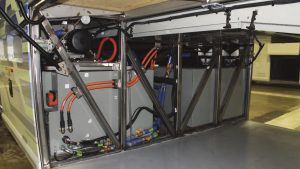 As you probably have already guessed, batteries for travel are a major component of the J4500e. MCI has elected to go with 450kWh Nickel Manganese Cobalt (NMC) batteries that are part of the Lithium Ion family. In addition to being heavy and expensive, they do take up a lot of room. Four of them are located in the second luggage bay and four more are towards the back of the engine compartment. There is a ninth battery located immediately behind the third luggage compartment in what I think was the area formerly used for the fuel tank.
As you probably have already guessed, batteries for travel are a major component of the J4500e. MCI has elected to go with 450kWh Nickel Manganese Cobalt (NMC) batteries that are part of the Lithium Ion family. In addition to being heavy and expensive, they do take up a lot of room. Four of them are located in the second luggage bay and four more are towards the back of the engine compartment. There is a ninth battery located immediately behind the third luggage compartment in what I think was the area formerly used for the fuel tank.
It should be noted that the MCI engineers put a lot of effort into battery placement. Battery location is very important from the standpoint of weight and balance, as well as for proper axle weight requirements.
In your garage or depot these batteries can be charged in about three hours using a 150 kW plug-in cable depot charger. Fully charged, they provide a range of about 200 miles, but this changes depending on the number of stops, road grade, average speed and the use of heat and air conditioning. In the future, the J4500e will also have the option of being equipped to charge along the way using an overhead or in-ground system. I should note that the J4500e does have a regenerative braking system that puts power back into the batteries when braking.
There is a need for infrastructure for charging since you cannot simply plug the coach into a conventional electrical outlet. You can have these special cables added in your garage or yard, but you obviously need to have enough incoming electric power to make them work.
In MCI’s case, given the need to move the electric coach around the country for various testing and customer demonstrations, they have purchased a standalone diesel generator trailer that can charge the coach for local use at any location. A dedicated truck pulls the generator while another dedicated truck with a flatbed transports the electric coach. This clearly illustrates the ease of moving diesel only powered vehicles. This is the same approach used by New Flyer to showcase their Xcelsior CHARGE electric bus. It is not really anticipated that regular bus operators would normally use this approach.
I should mention that in addition to the banks of NMC batteries, the J4500e still has a regular 12/24V bus battery. This is used for the lights and other low-voltage items on the coach.
Engine Compartment
 When you look into the engine compartment, there are two things you immediately notice. One is that there is no engine. The second is that it is very clean since there is no diesel fuel or larger quantities of lubricants.
When you look into the engine compartment, there are two things you immediately notice. One is that there is no engine. The second is that it is very clean since there is no diesel fuel or larger quantities of lubricants.
Looking into the engine compartment from the rear, you will find the fans on the left where they always were, but now they are electric fans. As you move from left to right across the engine compartment what you see are several boxes. Towards the left on top is the AUX Inverter. Below that are several different electrical components including the motor inverter, the high voltage fuse box, inverter for the motor, and DC/DC converter to supply the 12/24V system and charge the coach batteries. The coach air compressor is towards the center but lower.
Behind these boxes and towards the front of the coach is the pack of four batteries. The actual electric motor for moving the coach is located below and a little forward of the batteries. It is connected directly to the coach driveline and there is no transmission. MCI uses a Siemens 2024 electric drive system that is designed to handle long distances and higher speeds. Members of the MCI staff have indicated that the coach can reach higher speeds but will be limited to 72 miles per hour due to tire ratings, as with all MCI vehicles. Also lower speeds are similarly more efficient and will extend the range of the coach. This type of electric motor has been proven in other electric bus operations.
Expect that your technicians and maintenance staff will be delighted with the J4500e CHARGE. I have talked with service people and technicians who work on electric buses. While I hear different things from different people, there are a few things that are typical. One is that they like working on the electric buses because they are cleaner. While you may still have to deal with road grit, there is no diesel fuel or DEF to get things dirty or sticky. Consider the fact that when your staff works on an electric bus in the garage, there is no need to connect an exhaust hose to the tailpipe because there is no tailpipe.
The second thing I hear is that electric buses are easy to maintain. Many of the parts and systems that cause the most trouble are gone. Belts are gone and hoses have been reduced. Fuel filters have been eliminated and there is no engine coolant, no starter and several other items have been simplified.
A third point is that the electrical components typically require less rebuilding and replacement than diesel bus components. There are examples of electric motors and other components from electric buses and streetcars being reused in new buses and railcars.
Comparison to the Diesel J4500
With the exception of the driveline and some components, the new electric J4500e is essentially the same coach as the diesel J4500. They are both 45 feet long, 102 inches wide and about 11 feet and 9 inches high. The passenger capacity on both is essentially the same . . . 56 passengers with high legroom for up to 60 passengers. Both offer Wi-Fi, electrical outlets and the optional RGB programmable lighting to upgrade the interior.
As a general rule, features and options available on the diesel J4500 will also be available on the electric J4500e. Both 45-foot models, as well as the 35-foot J3500, will now have the new swing-out radiator and e-Fan system. This replaces the traditional belt-driven systems and also eliminates the need for a fan clutch, a miter box and driveshaft. The e-Fan system quickly swings out to provide easy access for faster maintenance and also eliminates the need to maintain and drain coolant.
Most other features found on the diesel J4500 will also be available on the electric J4500e. This includes the latest-generation Bendix Fusion collision mitigation system that was recently upgraded with a forward-facing camera with vehicle recognition software to detect and stop for stationary vehicles in the roadway. The system also offers lane departure warning and traffic sign recognition. A new 360-degree camera provides improved visibility, especially during low speed operation, and can serve to avoid some costly repairs.
It should be noted that the electric J4500e will have the same high level of support as the other MCI models. This includes support by the 24/7 technical call center, technical training and parts supply through NFI parts.
Test Drive
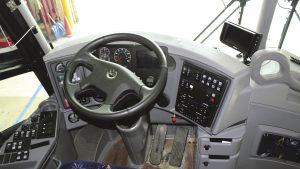 I was fortunate in having prior experience in driving electric buses including both those with hub motors and the direct drive system. In spite of the fact that some of the electric bus components and systems are different, I find that there is no substantial difference in the driving and only a little difference in monitoring gauges and systems.
I was fortunate in having prior experience in driving electric buses including both those with hub motors and the direct drive system. In spite of the fact that some of the electric bus components and systems are different, I find that there is no substantial difference in the driving and only a little difference in monitoring gauges and systems.
Like diesel buses, you will find a battery shut off switch. If your company policy is to shut off the batteries overnight or when the coach is not in use, you probably want to continue this procedure. Some people are talking about adding solar panels to the roof. They really do not generate that much power but can be helpful in making sure that your battery system is “topped off.”
Sliding into the driver’s seat, you will see very few differences from a diesel bus. With the diesel bus, you have to start the engine and may have to wait for the air system to build up. With an electric bus, you simply turn the bus on. If your air pressure is low, you will still have to wait for it to build up. While the diesel engine runs continuously,the electric motor only runs when the bus is moving.
Your gear selector is no longer a gear selector. Expect to see D, N and R only. This is because the J4500e has no transmission and no gears. The electric motor is connected directly to the driveline and simply runs faster for higher speeds.
Different from a diesel bus is the fact that you will see new gauges and indicators on the dash that show you the amount of charge remaining in your batteries and the amount you are using. Essentially, your remaining battery charge is similar to the fuel gauge on a diesel-powered coach. If you run out of diesel fuel or battery charge, the coach is not going anywhere. Hence, you need to monitor your battery charge much like you monitor a fuel gauge.
Let me expand this thought in two ways. One is that with a diesel bus you are essentially charging your batteries all of the time. This is because your engine is always running, consuming fuel and turning the alternator. With a battery-electric bus you are essentially discharging your batteries all of the time. Make sure you do not run out of battery charge. MCI has indicated that their electric coaches can be fitted with plans to provide a variety of recharging strategies such as en route overhead or in-ground charging systems along the way to extend the range of the coach. Note that alternate charging systems may only work in certain applications. It is anticipated that most operations will have depot charging at a home base.
A second thought I will share with you is that – depending on outside temperatures and your use of heat and air conditioning – maybe less than half of the electricity being used will be going to actually move the coach. One test using MCI telematics showed that 44 percent of the electric power was going to move the coach, 24 percent was used on the high voltage accessories, low voltage accessories used 18 percent and the remaining 14 percent was used to run the electric heater.
A side note is that while the same diesel bus can be sold to different operators, these electric buses may be modified or have options for individual buyers. In addition to modifying the battery system to individual needs, some operators may want some type of along-the-way charging capabilities included on their coaches.
This has been simplified for customers. New Flyer and MCI have invested in a dedicated infrastructure Project Management Team that is based in the MCI/New Flyer Vehicle Innovation Center (VIC) in Anniston, Alabama. This group will sit down with you to learn your operating requirements and needs, as well as in-field route mapping and analysis. They will then help you spec your coaches properly and also assist with charging strategy and infrastructure planning.
The Romans called it “caveat emptor,” which translates into “Let the buyer beware.” I have seen some electric bus ranges mentioned that seem impossible – because they are. If you turn off some of the accessories as well as the heat and air conditioning, and then use an ideal test track, you too can get some impressive range numbers. In comparison, the MCI people have been working with “real world miles” and can honestly tell you how heating, air conditioning, grades and accessory loads will impact your operation.
You get the coach moving in the usual way by taking off the parking brake, hitting the “D” button and pressing down on the accelerator. The first thing you will notice is that acceleration is both quiet and smooth. Since there are no gears, the electric motor simply turns faster to provide more speed. This smooth and quiet acceleration is often noted positively by the passengers.
While “jack rabbit” starts are usually not recommended, I can say that the J4500e seemed more than capable of matching or beating the diesel buses “out of the gate.” In fact, there are places with hills, like Seattle, that prefer electric buses because they seem to do better on hills. MCI is using a high-torque electric motor for these same reasons.
When you slow down, you will most likely feel the regenerative braking kicking in. Regenerative braking is nothing new and has been around for a century on electric locomotives. What happens is that regenerative braking turns your electric motor into a generator and feeds electric power back into the battery system. This extends the range of the coach and does suggest that operations with substantial braking, such as commuter or shuttle runs, will actually build up some charge along the way.
The team at MCI advised that the current setup for both acceleration and regenerative braking is to closely mirror the performance and drivability of diesel coaches, which makes the vehicle more comfortable for operators and drivers.
Coach handling was great as always, but I think we have to credit this to MCI and the J4500 and not to the new battery-electric system. While some of the systems and components are different, the suspension and ride remain impressive. The only difference I noted was in the new electric (over hydraulic) steering system. While I had no problem with the former system, I did like this new steering better. It might be difficult to come up with an exact reason, but I liked the feel of the system and it seemed somehow a little more positive.
Testing and Production
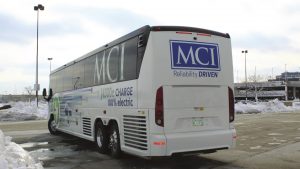 I should stress that the coach we drove and photographed was actually the first prototype of the J4500e. It had been originally built as a diesel coach but was used for the first electric prototype. Hence, the exact placement of some components may be changed by the time regular production starts. Regular production coaches will certainly have the high-quality fit and finish we expect from MCI.
I should stress that the coach we drove and photographed was actually the first prototype of the J4500e. It had been originally built as a diesel coach but was used for the first electric prototype. Hence, the exact placement of some components may be changed by the time regular production starts. Regular production coaches will certainly have the high-quality fit and finish we expect from MCI.
What is anticipated is that as we roll into 2019, MCI plans to have an electric J4500e coach and electric D45 CRTe LE low entry Commuter Coach on the road for testing and demos. [D=MCI “D” model, 45=45 feet long, CRT=Commuter Rapid Transit, e=electric and LE=Low Entry.] The D45 CRT LE, for example, will have to go back to Altoona, a test they recently passed with their diesel version. These coaches may be operated at times by MCI staff or may be used as customer test vehicles. Their purpose is to gather information in actual operation and provide feedback to the factory engineers on ways to improve systems and design prior to the start of production.
Expectations are that the testing and engineering should be completed in the first half of 2020 and that regular production will start later in the year. The first production units of the electric J4500e CHARGE should roll off the assembly line somewhere around September of 2020.
For those who ask, at least two additional MCI electric coach models are currently planned for the future. All of this electric range is planned to carry the CHARGE branding, which is common with New Flyer. One would most likely be called the D45 CRTe CHARGE. It will be similar to the D45 CRTe LE but without the lower vestibule. Hence, it will eventually replace the traditional D4500 and D4505 scheduled service and commuter coaches in the MCI product line and be offered in either diesel or electric. In addition, an electric version of the new 35-foot coach, probably designated as the J3500e CHARGE, will become available. However, the engineering and components on the J3500e may be somewhat different because of its shorter length.
Keep watching the news for information on these new electric coaches being developed, being shown and going into production.

